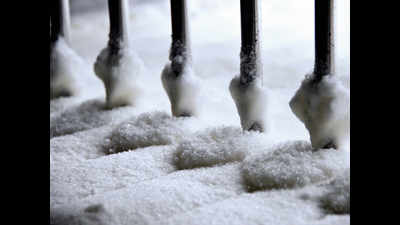- News
- City News
- lucknow News
- Sugar glut: Output up 12 lakh tonnes despite ethanol diversion in Uttar Pradesh
Trending
This story is from December 4, 2020
Sugar glut: Output up 12 lakh tonnes despite ethanol diversion in Uttar Pradesh
Enhanced sugar recovery in current crushing season in Uttar Pradesh was evident from jacked-up production by at least 111 operational mills despite diverting B-heavy molasses for ethanol. Experts say high production could once again trigger a sugar glut, resulting in price drop.

Sources said the Centre is promoting diversion of B-heavy molasses for production of ethanol, which yields better rates to millers
LUCKNOW: Enhanced sugar recovery in current crushing season in Uttar Pradesh was evident from jacked-up production by at least 111 operational mills despite diverting B-heavy molasses for ethanol. Experts say high production could once again trigger a sugar glut, resulting in price drop.
November 30 data by Indian Sugar Mills Association (ISMA) showed as many as 28 mills diverted B-heavy molasses — first stage of cane juice processing — for production of ethanol, which is essentially used to supplement fuel, mainly petrol.
In the corresponding period in 2019, only 18 mills diverted B-heavy molasses for ethanol production. Despite this, sugar production in the state has gone a notch higher to 12.65 lakh tonnes in comparison to 11.46 lakh tonnes last year.
Nationally, 408 sugar mills were in operation as on November 30 and have produced 42.90 lakh tonnes of sugar. In comparison, by November 30 last year, 309 mills were in operation and generated 20.72 lakh tonnes of sugar.
“This also results in reduction of sugar production. Since the price of sugar has not been rising, millers are diverting intermediate molasses for ethanol production to increase their income,” an ISMA official said. Ethanol is produced with the help of extra neutral alcohol, experts said.
November 30 data by Indian Sugar Mills Association (ISMA) showed as many as 28 mills diverted B-heavy molasses — first stage of cane juice processing — for production of ethanol, which is essentially used to supplement fuel, mainly petrol.
In the corresponding period in 2019, only 18 mills diverted B-heavy molasses for ethanol production. Despite this, sugar production in the state has gone a notch higher to 12.65 lakh tonnes in comparison to 11.46 lakh tonnes last year.
Nationally, 408 sugar mills were in operation as on November 30 and have produced 42.90 lakh tonnes of sugar. In comparison, by November 30 last year, 309 mills were in operation and generated 20.72 lakh tonnes of sugar.
The fresh projection vis-à-vis sugar production comes ahead of UP government’s decision to revise State Advisory Price (SAP), which fixes compensation to farmers by mills. “B-heavy molasses has higher sugar contest, which results in greater ethanol content,” said a miller. “However, in the process, the mills compromise on sugar,” he added. Experts said because of diversion of B-heavy molasses to ethanol, sugar production gets reduced by around 1.5% in comparison to sugar recovered from C-heavy molasses, which is final stage of cane juice processing. Sources said, the Centre is promoting diversion of B-heavy molasses for production of ethanol, which yields better rates to the millers. “It is a kind of incentive by the Centre to mills,” an official said.
“This also results in reduction of sugar production. Since the price of sugar has not been rising, millers are diverting intermediate molasses for ethanol production to increase their income,” an ISMA official said. Ethanol is produced with the help of extra neutral alcohol, experts said.
End of Article
FOLLOW US ON SOCIAL MEDIA










